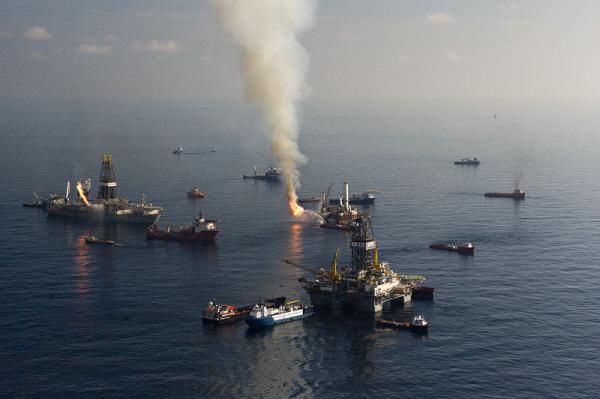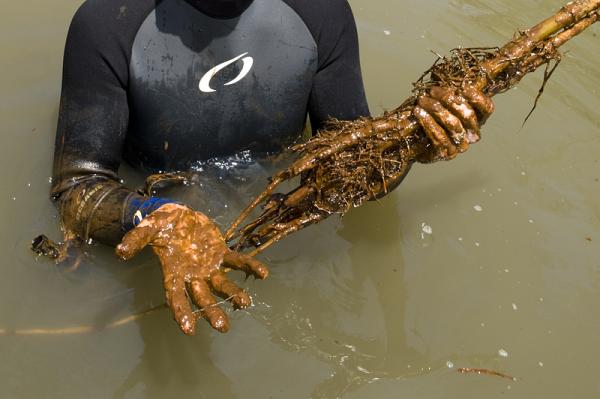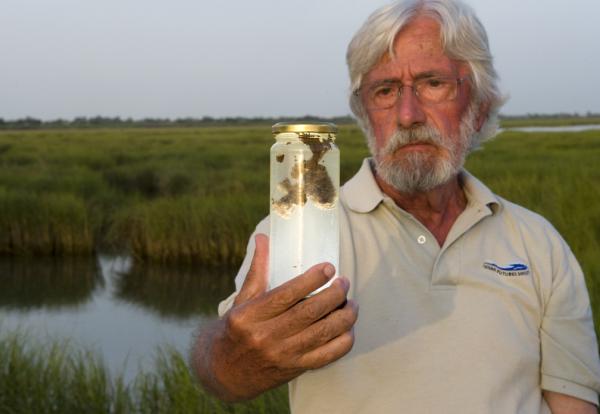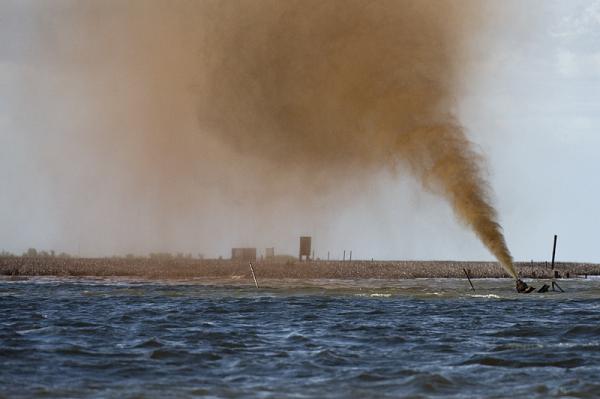Six Years After the Worst Oil Spill in American History, What Is Going on in the Gulf?
Six years ago on April 20, 2010 in the heart of the Gulf of Mexico,
the BP Deepwater Horizon oilrig exploded into a fireball that could be seen from shore,
killing 11 workers and opening a gaping hole in the seafloor that would spew 200 million gallons of oil into the ocean for months on end.

It was a catastrophe of epic proportions – human lives were lost, local economies plummeted, and the ocean and all of its creatures were suddenly caught in a toxic mess. Dispersants were added to the ocean to make the surface oil disappear, but the oil did not disappear. Six years later, 10 million gallons of oil remain – 10% of the entire seafloor in the Gulf of Mexico is currently covered in a mat of oil and toxic dispersants that continues to contaminate marine life throughout the food web.
Ocean Futures Divers First in the Water
The Ocean Futures Society team traveled to the Gulf of Mexico shortly after the BP explosion in 2010 while oil was still seeping from the broken well 5,000 feet below the surface. For 87 days, nobody could figure out how to stop it. Our team was the first to put divers in the water, capturing footage of the oil plumes drifting in the Gulf currents that was seen on national news. At the time, we didn’t fully realize the risks we had put our divers in, we simply wanted to understand what was going on beneath the surface of the ocean and show it to people around the world.
Dolphins were giving birth in the oil, we witnessed mothers breastfeeding their calves surrounded by a sea of toxic waste. Following the spill, thousands of dolphins, especially young juveniles and newborns, were found dead on the shorelines of the Gulf. Recent studies linking dolphin deaths to the BP oil spill are adding to a growing body of research pointing to the overwhelming evidence that oil and dispersants severely harmed dolphin’s respiratory and reproductive health. Today, dolphins in Barataria Bay are having major difficulties giving birth to healthy young. As we’ve seen from past oil spills, reproductive damage can affect populations for decades into the future, and even affect the survival of local species populations.
As for seafood in the Gulf, although it is considered safe to eat, there are many questions that remain. What about the massive mat of oil sitting on the seafloor? Everything is connected. Smaller creatures living in the deep ocean on the seafloor ingest or absorb the oil, which are then eaten by larger worms and shrimps, which are then consumed by bigger fish, until the biggest fish ends on our dinner plate. After the oil spill, numerous fisheries closed due to the high levels of contamination found in animals both in the deep sea and shallow waters. Now, scientists are trying to understand if the oil caused long-term damage to their DNA, which could affect their health and reproduction, and the future of many species we depend upon in the Gulf.
And what about the people who cleaned up oil gushing into their backyards? What choice did fishermen and others who relied on the ocean have other than help fix the problems created by BP’s oil spill? Although BP assured cleanup crews that the added dispersant was safe, studies of the dispersant, Corexit, found that combined with the oil, the mixture is 20 times more toxic to people and the environment than either alone. The dispersant creates smaller oil droplets that can pass more easily into the tissues of animals and people. BP discouraged cleanup crews from wearing respirators to protect themselves due to the negative publicity the images would send. Soon after the spill, workers reported headaches, nausea, skin rashes and chronic coughs. Six years later, these symptoms have turned into debilitating diseases, cancers and death. No amount of money can give people back their livelihoods or lives that were lost to the negligent actions of BP who cut safety corners at the cost of human lives for exorbitant profits.

Six Years Later – Where Are We Now?
Six years later, the US Department of Justice has finally approved a settlement, forcing the company, British Petroleum, BP, to pay $20 billion to local, state, and federal agencies because they acted with ‘gross negligence and willful misconduct’ that was responsible for the nation’s most disastrous oil spill in history. The settlement marks the largest environmental fine ever imposed on a corporation. But what value can be put on the real damages done to families, communities, wildlife, and natural resources? In total, BP claims it will pay over $55 billion in fees. Can you image how far $55 billion could have gone towards investing in renewable energy and technology?
Six years later, the US Department of Interior has just issued new safety regulations on the oil industry. The new safety rules are designed to update industry standards and improve drilling techniques and technology to minimize the risk of well out blow, which happened six years ago on the Deepwater Horizon. Already, the oil industry has opposed them, fearing the regulations will be too costly. Many experts say the new regulations do not go far enough to protect people and the environment from another major tragic spill. How can we allow any company, let alone one of the largest industries in the world, to continue when they are not even willing to strengthen and improve the safety of their business operations? The damage they’ve already caused is untold, innumerable, and will continue to impact the Gulf of Mexico for decades to come.

We know that oil spills cause incalculable damage, not only to the environment and animals we depend upon, but also to the societies, economies, health and livelihoods of populations of people living near these oil spills. Oil spills happen every single day in our country and around the world. It is not a question of if there will be another major spill, but when? Now we must ask ourselves, how do we stop it from happening again?
The Clean Energy Movement is Happening Now
The momentum for clean energy is growing. There has been a major increase in renewable energy investments. Wind and solar energy are becoming increasingly more affordable in start up costs, and renewable technologies have become the largest source of new energy production in recent years. After the historic COP21 Climate talks in Paris in December 2015, where over 150 nations agreed to limit the amount of carbon dioxide in the atmosphere from the burning of fossil fuels, countries around the world are creating ambitious renewable energy standards. It is only a matter of time as the economics of renewable sources becomes more affordable and efficient.

The time for change is now. We do not have the luxury to wait any longer. Our planet is warming rapidly from the burning fossil fuels and our human actions are accelerating the changing climate of Earth. The ice caps are melting, the seas are rising, oceans are acidifying, diseases are spreading, droughts and floods are increasing, on and on the consequences cascade. The planet’s changing climate and oceans will affect every aspect of our lives. In the past, we did not know. Now, the knowledge is overwhelming, the science is clear, the planet is changing, and we must change too – starting with the way we power our world. We must learn from nature, and learn to live in better balance with our water planet so that our species and others continue to prosper into the future.
Warm regards,

Jean-Michel Cousteau
President, Ocean Futures Society
with Jaclyn Mandoske
Donate to Two Futures Society
Yes! I want to support the field work, projects and mission of Jean-Michel Cousteau and the OFS team. Make a tax-deductible donation now!
Become a Member
Yes! Sign me up for a free membership!
Connect With Us